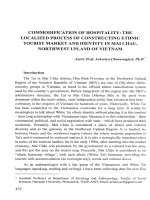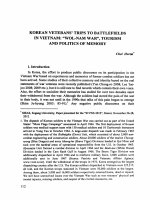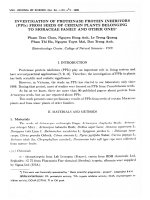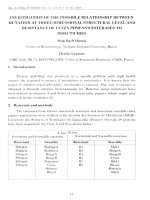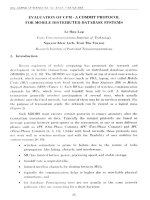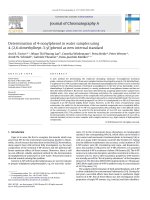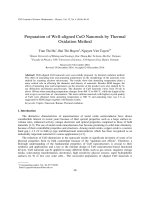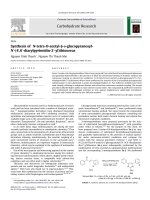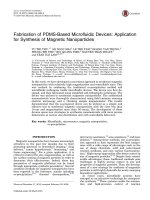DSpace at VNU: Fabrication of TbPO 4 ·H2O nanorods nanowires by the microwave technique and their characterization
Bạn đang xem bản rút gọn của tài liệu. Xem và tải ngay bản đầy đủ của tài liệu tại đây (595.5 KB, 5 trang )
Home
Search
Collections
Journals
About
Contact us
My IOPscience
Fabrication of TbPO4·H2O nanorods/nanowires by the microwave technique and their
characterization
This content has been downloaded from IOPscience. Please scroll down to see the full text.
2012 Adv. Nat. Sci: Nanosci. Nanotechnol. 3 015007
( />View the table of contents for this issue, or go to the journal homepage for more
Download details:
IP Address: 129.93.16.3
This content was downloaded on 03/02/2015 at 11:56
Please note that terms and conditions apply.
IOP PUBLISHING
ADVANCES IN NATURAL SCIENCES: NANOSCIENCE AND NANOTECHNOLOGY
Adv. Nat. Sci.: Nanosci. Nanotechnol. 3 (2012) 015007 (4pp)
doi:10.1088/2043-6262/3/1/015007
Fabrication of TbPO4·H2O
nanorods/nanowires by the microwave
technique and their characterization
Thanh Huong Nguyen1 , Duc Van Nguyen1 , Manh Tien Dinh1 ,
Thi Khuyen Hoang1 , Thanh Binh Nguyen1 and Quoc Minh Le1,2
1
Institute of Materials Science, Vietnam Academy of Science and Technology, 18 Hoang Quoc Viet
Road, Cau Giay District, Hanoi, Vietnam
2
University of Enineering and Technology, National University Hanoi, 144 Xuan Thuy Road,
Cau Giay District, Hanoi, Vietnam
E-mail:
Received 17 January 2011
Accepted for publication 6 January 2012
Published 21 February 2012
Online at stacks.iop.org/ANSN/3/015007
Abstract
This report presents the results of the fabrication of luminescent terbium orthophosphate
monohydrate (TbPO4·H2 O) nanomaterials prepared by the microwave synthesis method and
their characterization. The effects of synthesis conditions such as microwave irradiated
powers, pH values and reaction temperature on properties of nanomaterials are also
investigated to obtain controllable size, morphology and strong luminescence. The structure,
morphology and optical properties of the nanomaterials have been characterized by x-ray
diffraction, field-emission electron scanning microscopy and fluorescence spectroscopy,
respectively. The results showed that TbPO4·H2 O nanowires/nanorods have been successfully
synthesized by using microwave heating of an aqueous solution of terbium nitrate and
NH4 H2 PO4 with pH values ranging from 2 to 10. The length and width of these
nanowires/nanorods are 150–350 nm and 5–10 nm, respectively.
Keywords: microwave-assisted synthesis technique, nanowires/nanorods, fluorescence
Classification numbers: 4.00, 4.06, 4.08
devices and biomedical fluorescence labeling [15–18]. These
rare-earth orthophosphate (LnPO4 with Ln: Y, Sc and La–Lu)
nanomaterials exhibit fascinating properties such as very high
thermal stability, low water solubility, high refractive index
and a high concentration of lasing ions. Possessing these
properties, LnPO4 can be used in various applications, such as
luminescent or laser materials, magnets, ceramics, catalysts,
proton conductors moisture-sensitive sensors, heat-resistant
materials, hosts for radioactive nuclear waste, biochemical
probes and medical diagnostics [19–21].
In this work TbPO4·H2 O nanorods/nanowires have been
prepared by microwave (MW) heating and characterized
by field-emission scanning electron microscopy (FE-SEM)
and x-ray diffraction (XRD). The microwave-assisted
synthesis technique is employed for the reasons of its high
possibility of providing low dimensional nanomaterials, and
that it is simple, very fast, clean, efficient, economical,
non-toxic and eco-friendly [19]. The microwave refluxing
1. Introduction
Recently, numerous methods for the synthesis of nanoparticles [1–6], nanotubes [7–9], nanowires [10, 11] and
nanorods [12, 13] with desired particle sizes and controlled
morphology have been developed. These nanomaterials with
different shapes have recently gained interest and become
more and more important due to their novel properties
associated with their reduced dimensionality and their
potential applications in nanotechnologies, especially in
nanobiophotonics [14].
Rare-earth compounds have been widely used in highperformance luminescent devices, magnets, catalysts and
other functional materials owing to the numerous well-defined
transition modes involving the 4f shell of their ions. Recently,
increasing interest has been focused on the synthesis and
photoluminescence of rare-earth orthophosphates with nanosized scale for their potential application in optoelectronic
2043-6262/12/015007+04$33.00
1
© 2012 Vietnam Academy of Science & Technology
Adv. Nat. Sci.: Nanosci. Nanotechnol. 3 (2012) 015007
T H Nguyen et al
(a)
(b)
(c)
Figure 1. FE-SEM images of TbPO4·H2 O nanorods/nanowires depending on MW irradiated powers at pH = 2. Power of (a) 300 W,
(b) 500 W, (c) 900 W.
apparatus was used with maximum power as high as
1000 W. The photoluminescence (PL) spectra under 370 nm
excitation wavelength of TbPO4·H2 O nanorods/nanowires
were measured in the wavelength range of 450–650 nm.
The photoluminescence excitation (PLE) spectra monitored
at 542 nm emission line were recorded in the wavelength
range of 300–525 nm. The effects of the microwave irradiated
power on crystalline structure, nanostructures and the
photoluminescence properties of prepared samples were also
discussed for the first time.
ranging from 300 to 900 W. From the investigation of the
effects of pH value of reaction suspension on structure and
the photoluminescence properties, which will be reported
in detail elsewhere [22], the optimized pH value of 2
was determined. The resulting products were collected,
centrifuged at 5600 rpm, and washed several times using
ethanol and distilled water. The final products were dried at
60 ◦ C for 24 h in air. The above experiments were repeated
several times and showed good reproductivity. The crystalline
phase identification of the as-synthesized samples was carried
out by XRD analysis with a Siemens D5000 diffractometer
(using CuKα radiation with λ = 1.5406 Å). The morphology
of the products was characterized by using a field emission
scanning electron microscope, Hitachi, S-4800. The excitation
and emission (fluorescence) spectra of studied samples were
recorded on a Cary eclipse fluorescence spectrometer and a
luminescence spectrophotometer system, Horiba Jobin Yvon
IHR 550, respectively.
2. Experimental
Terbium(III) nitrate and NH4 H2 PO4 with 99% purity were
purchased from Aldrich Co. and used as-received without
further purification. TbPO4·H2 O nanomaterials were prepared
by microwave heating of an aqueous solution of terbium(III)
nitrate and NH4 H2 PO4 at atmospheric pressure in an open
system. In a typical synthesis, 20 ml of aqueous 0.25 M
NH4 H2 PO4 solution was added into a 50 ml round-bottomed
flask containing 20 ml of a 0.25 M aqueous solution of
Tb(NO3 )3 . A colloidal suspension, without any special
morphology of particles, was obtained upon the addition
of NH4 H2 PO4 into Tb(NO3 )3 solution. Different pH values
of the reacting solution were intentionally selected in the
range of 2–10 by using 0.05 M NH4 OH solution. At each
selected pH value, this reacting solution was then irradiated
using a MAS-II microwave synthesis extraction workstation,
Sineo Co., for 30 min with different irradiated powers
3. Results and discussion
FE-SEM images of TbPO4·H2 O samples synthesized by
using microwave heating of an aqueous solution containing
Tb(NO3 )3 and NH4 H2 PO4 at pH = 2 with various microwave
irradiated powers ranging from 300 to 900 W were shown in
figure 1.
The nanorods/nanowires are uniformly distributed with
diameters in the range of 5–10 nm and lengths ranging
from 150 to 350 nm (figures 1(a) and (b)). There exists
a critical value of irradiated power of 500 W for these
2
Adv. Nat. Sci.: Nanosci. Nanotechnol. 3 (2012) 015007
T H Nguyen et al
700
600
Intensity (a.u.)
500
a
TbPO4.H2O-400W-pH=2
b
TbPO4.H2O-600W-pH=2
c
TbPO4.H2O-800W-pH=2
400
300
200
c
b
100
a
0
10
20
30
40
2θ (ο)
50
60
70
80
Figure 2. XRD patterns of TbPO4·H2 O nanowires synthesized by
using microwave heating of an aqueous solution containing
Tb(NO3 )3 and NH4 H2 PO4 at pH = 2 with irradiated power of:
(a) 400 W, (b) 600 W, (c) 800 W.
Figure 3. Coordination sphere of the Tb3+ cation with nearest
neighbor oxygen atoms (top) and with four PO3−
4 anions and two
hydrate water molecules (bottom) in the crystal structure of
TbPO4·H2 O.
nanorods/nanowires tending to bunch with the further
increase of microwave irradiated powers as shown in
figure 1(c), for example.
XRD patterns of the as-synthesized TbPO4·H2 O
nanorods/nanowires indicate that only single crystalline
phase of TbPO4·H2 O existed in the obtained samples
(figure 2). All diffraction peaks can be distinctly indexed to
a rhabdophane-type pure hexagonal phase. These results are
the same as those reported previously [19]. Qualitatively,
as shown in figure 2, the switching of microwave irradiated
power causes no change in crystalline phase composition or
crystallinity of the prepared samples. This implies that, by
using microwave synthesis apparatus and an aqueous solution
containing Tb(NO3 )3 and NH4 H2 PO4 at a suitable pH = 2
of starting solution, the hydrated terbium orthophosphate,
TbPO4·H2 O, was always obtained as a unique product
instead of anhydrous TbPO4 . In the crystal structure of
this monohydrate salt [19], each Tb3+ cation is not only
coordinated by oxygen atoms which reside at two different
crystallographic sites, O1 and O2, of PO3−
anions as
4
observed in the case of TbPO4 [23], but is also connected
to oxygen atoms (O3w) of two hydrate water molecules
(figure 3). The interatomic distances between Tb3+ cation
and oxygen atoms of two hydrate water molecules of about
2.6 Å are significantly longer than those of Tb3+ cation and
oxygen atoms of PO3−
4 anions (about 2.3 Å). As a result, it
is quite reasonable to expect that TbPO4·H2 O nanomaterials
exhibit higher hydrophilicity and more chemical activities
in water medium than those of TbPO4 . It is really a
perspective result regarding to biomedical fluorescence
labeling application, which required high hydrophilicity of
luminescent nanomaterials.
PLE spectra of TbPO4·H2 O nanorods/nanowires were
recorded on the Cary eclipse fluorescence spectrometer.
Excitation bands at 310, 350, 370 and 480 nm were observed
in PLE spectra monitored at 542 nm emission line for all
measured samples. The PLE spectra of the as-synthesized
TbPO4·H2 O sample at 400 and 600 W power are shown in
figure 4. The peak in PLE spectra at 480 nm is due to the spin
40
35
a
TbPO4.H2O-PMw= 400W - pH = 2
b
TbPO4.H2O-PMw= 600W - pH = 2
Intensity (a.u.)
30
25
a
20
15
b
10
5
0
300
325
350
375
400
425
450
475
500
525
Wavelength (nm)
Figure 4. The PLE monitored at 542 nm of TbPO4·H2 O prepared
with microwave irradiated powers of: (a) 400 W; (b) 600 W.
allowed 7 F6 –5 D4 transition of the Tb3+ ions. The other peaks
at 350, 370 and 310 nm are assigned to the intra 4f8 transitions
between the 7 F6 –5 L10-7 and 7 F6 –5 H7-4 , respectively [15]. It
can be concluded that the excitation spectra of TbPO4·H2 O
nanorods/nanowires arose from the transitions in trivalent
terbium ion Tb(III).
Figure 5 showed the PL spectra under 370 nm excitation
of TbPO4·H2 O nanowires synthesized by using microwave
heating of an aqueous solution containing Tb(NO3 )3 and
NH4 H2 PO4 at pH = 2 with different irradiated powers.
Obviously, the emission intensity varied as a function of
irradiated power and reached a maximum value with 500 W.
With a higher value of irradiated power the formation
of TbPO4·H2 O nanobunches might be a reason for the
reduction in emission intensity. For prepared TbPO4·H2 O
nanorods/nanowires, the emission bands centered at 488, 542,
3
Adv. Nat. Sci.: Nanosci. Nanotechnol. 3 (2012) 015007
542
488
1
2
3
4
5
6
7
TbPO4.H2O-400W
500
550
600
3x10
TbPO4.H2O-600W
TbPO4.H2O-700W
4
2x10
TbPO4.H2O-800W
TbPO4.H2O-900W
4
1x10
620
7
450
4
TbPO4.H2O-500W
584
6
5
4
References
4
4x10
TbPO4.H2O-300W
3
2
Intensity (Counts)
λex= 370nm, 5s
T H Nguyen et al
[1] Giang L T K, Opalinska A, Chudoba T, Benkowski K,
Lojkowski W, Anh T K, Binh N T and Minh L Q 2010 Adv.
Nat. Sci: Nanosci. Nanotechnol. 1 025008
[2] Dung D T M, Hanh N T M and Phuoc N H 2010 Adv. Nat. Sci:
Nanosci. Nanotechnol. 1 025011
[3] Hien V X, Anh L T H, Trung K Q, Vuong D D and Chien N D
2010 Adv. Nat. Sci: Nanosci. Nanotechnol. 1 025014
[4] Long N V, Chien N D, Hirata H, Ohtaki M, Hayakawa T and
Nogami M 2010 Adv. Nat. Sci: Nanosci. Nanotechnol.
1 035012
[5] Gajendiran J and Rajendran V 2011 Adv. Nat. Sci: Nanosci.
Nanotechnol. 2 015001
[6] Dung D T M, Thu L T T, Fribourg-Blanc E and Chien D M
2011 Adv. Nat. Sci: Nanosci. Nanotechnol. 2 015009
[7] Nguyen T A, Nguyen P T H, Dinh D H, Dang M C, Song W,
Jung D, Kim S K and Park C 2010 Adv. Nat. Sci: Nanosci.
Nanotechnol. 1 015010
[8] Michel T, Paillet M, Zahab A, Nakabayashi D, Jourdain V,
Parret R and Sauvajol J-L 2010 Adv. Nat. Sci: Nanosci.
Nanotechnol. 1 045007
[9] Trinh P V, Thang B H, Trung T B, Tu N V, Quang L D, Tinh
T X, Chuc N V, Phuong D D and Minh P N 2011 Adv. Nat.
Sci: Nanosci. Nanotechnol. 2 015006
[10] Hien T D, Duy T P, Tung P X T, Binh P V, Tuyen L T T, Chien
D M and Van Rijn C J M 2010 Adv. Nat. Sci: Nanosci.
Nanotechnol. 1 015011
[11] Hung N L, Kim H, Hong S-K and Kim D 2011 Adv. Nat. Sci:
Nanosci. Nanotechnol. 2 015002
[12] Trung K Q, Hien V X, Vuong D D and Chien N D 2010 Adv.
Nat. Sci: Nanosci. Nanotechnol. 1 025010
[13] Wu X, Zheng Y and Qu F 2010 Adv. Nat. Sci: Nanosci.
Nanotechnol. 1 035005
[14] Patra C R, Bhattacharya R, Patra S, Basu S, Mukherjee P and
Mukhopadhyay D 2006 J. Nanobiotechnol. 4 11
[15] Yang M, You H P, Song Y H, Huang Y J, Jia G, Liu K, Zheng
Y H, Zhang L H and Zhang H J 2009 J. Phys. Chem. C
113 20173
[16] Wang D and Wang Y H 2009 Mater. Chem. Phys 115 699
[17] Ha C V, Lien N T H, Huyen L T, Thuy U T D, Huan L Q,
Thuan T K, Liem N Q and Nhung T H 2010 Adv. Nat. Sci:
Nanosci. Nanotechnol. 1 025005
[18] Lien N T H, Huyen L T, Hoa V X, Ha C V, Hai N T, Huan
L Q, Fort E, Hoa D Q and Nhung T H 2010 Adv. Nat. Sci:
Nanosci. Nanotechnol. 1 025009
[19] Patra C R, Alexandra G, Patra S, Jacob D S, Gedanken A,
Landau A and Gofer Y 2005 New J. Chem. 29 733
[20] Di W, Wang X, Zhu P and Chen B 2007 J. Solid State Chem.
180 467
[21] Di W, Willinger M G, Ferreira R A S, Ren X, Lu S and Pinna
N 2008 J. Phys. Chem. C 112 18815
[22] Huong N T, Van N D, Tien D M, Tung D K, Binh N T, Anh
T K and Minh L Q 2011 J. Rare Earths 29 1170
[23] Milligan W O, Mullica D F, Beall G W and Boatner L A 1983
Inorg. Chim. Acta 70 133
0
1
650
Wavelength (nm)
Figure 5. PL spectra under 370 nm excitation of TbPO4·H2 O
nanowires synthesized by using microwave heating of an aqueous
solution containing Tb(NO3 )3 and NH4 H2 PO4 at pH = 2 with
irradiated power of: (1) 300 W, (2) 400 W, (3) 500 W, (4) 600 W,
(5) 700 W, (6) 800 W and (7) 900 W.
584, 620 nm are assigned to 5 D4 →7F J transitions (J = 6,
5, 4, 3), respectively. The maximum emission peak is found
at value 542 nm of wavelength corresponding to 5 D4 –7 F5
transition.
4. Conclusion
Nanorods/nanowires of TbPO4·H2 O have been successfully
fabricated using microwave technique. The length and width
of these nanowires/nanorods are 150–350 nm and 5–10 nm,
respectively. These TbPO4·H2 O nanomaterials possess
rhabdophane-type pure hexagonal structure. The microwave irradiated power clearly affects the intensity of photoluminescence spectra of prepared samples. TbPO4·H2 O
nanowires/nanorods exhibit the characteristic narrow
emission peaks of trivalent terbium ion. The fluorescent
intensity reaches a maximum value with 500 W of irradiated
power.
Acknowledgments
This work has been supported by Vietnam Basic Research
Programming for Application, project 2/2/742/2009/HDDTDL. The authors are also grateful to the Key Laboratory
of Electronic Materials and Devices, Institute of Materials
Science, and all the members of x-ray diffraction, FE-SEM
and PL groups for their technical assistance.
4

